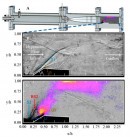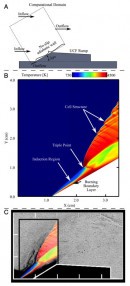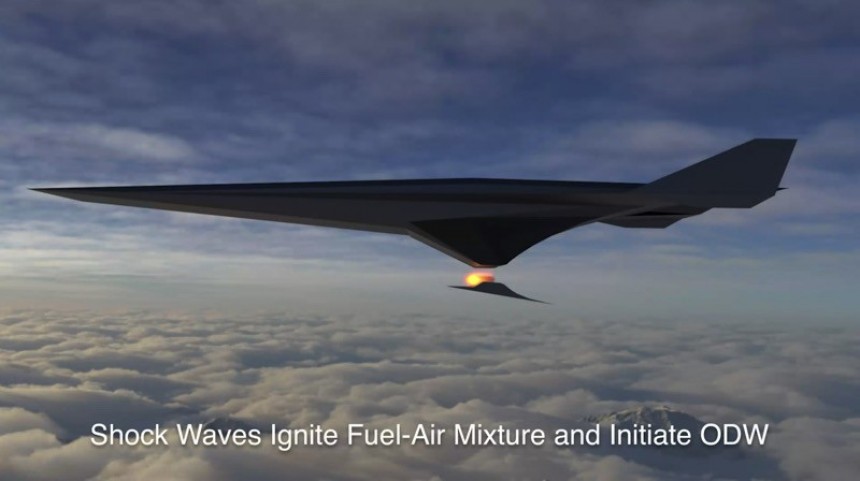The bright minds from the University of Central Florida (UCF) are on a path to revolutionize the future of air travel, and even facilitate interplanetary transportation.
In the quest to find a reliable and safe solution for efficient supersonic and hypersonic propulsion, researchers have turned their sights to combustion waves created by exothermic reactions.
Two types of reactions that create combustion waves are known to exist: deflagration and detonation. A deflagration produces subsonic shock waves, and it is an inefficient process, so it is a no-go for the purpose of this study. On the other hand, detonation shocks are ultra high-speed supersonic reaction waves that are highly energetic, and could produce more thrust than any other form of propulsion currently in use.
The UCF research team took this approach and created a unique experimental configuration (check video below) that produces a fixed-in-place (crucial aspect) detonation and a high-enthalpy shockwave. The basic working principle of this architecture relies on an oblique detonation wave, stabilized on a ramp, created in a hypersonic flow of hydrogen and air.
A detonation is an intricate chemical and physical process that results in a supersonic combustion wave. These waves travel at many times the speed of sound - in the case of a hydrogen-air mixture system, that would be Mach 5 territory. But, an engine operating at Mach 5 flow speed translates into a vehicle propulsion speed of between Mach 6 to Mach 17. That is serious business!
Three types of detonation engine concepts have been researched until now in the scientific world: pulse detonation engines, rotating detonation engines, and oblique detonation wave engines (ODWE). The latter is of much interest for aircraft transportation purposes because of its theoretical capability of thrusting a vehicle to speeds suitable even for space travel.
An oblique detonation wave (ODW) is sustainable as long as the fueling process goes uninterrupted. Experiments have concluded that the nature of the reacting shock wave flow is quite turbulent. For the detonation wave to be stable, the trick is to achieve the ideal balance of fuel mixture, burning temperature, and heat release during the high-Mach flow.
For example, high heat release causes the detonation to propagate upstream, opposite to the flow needed to fly the vehicle in the right direction. In contrast, too little heat causes the detonation process to transform into a deflagration which, as stated before, is ineffective for the purpose at hand. The researchers have resorted to computer simulation software using a compressible flow model to achieve a correct balance.
After the theoretical work and design were complete, the research team went to the High-Enthalpy Hypersonic Reacting Facility (HyperReact) at the University of Central Florida for tests. The equipment there consists of an inflow preheater, a mixing chamber, main fuel injection stage, converging-diverging (CD) nozzle, and the optically accessible test section.
The inflow preheater comes as a hydrogen-air jet flame which is surrounded by evenly-spaced air jets to help achieve a constant temperature. The mixing chamber consists of a channel that allows for a homogenous mixture to form and take its course towards the next section, which is the CD nozzle. This one has an axisymmetric square cross-section along its entire length and a throat height of about 0,35 inches (9 mm). The throat to inlet and outlet ratios give the nozzle a characteristic shape that greatly helps achieve a flow exiting speed of Mach 5.
When the supersonic flow enters the last stage, the fuel and air mass flows are precision-measured using choked orifices. To help stabilize the detonation wave, a 30 degrees angle ramp is used, positioned downstream of the CD nozzle, and spanning the entire width of the test section.
The oblique detonation wave is recorded using high-speed chemiluminescence imaging. The test section comes with fused quartz windows that offer full visual access for the high-speed cameras to capture real-time images at 30 kilo-frames per second!
Considering that a detonation cycle lasts around a few microseconds, the UCF team managed to keep the engine functioning just for several seconds - enough for them to gather all the needed data and not cause any damage to the prototype.
The research paper that came as a result of these experiments was founded by the Air Force Office of Scientific Research, NASA, and the National Science Foundation. For now though, there is no telling when such a technology could become available.
Yet this remarkable experiment is gratifying and makes us believe that Mach 17 flight speeds and half-our journies from one continent to another could become part of everyday reality someday.
Two types of reactions that create combustion waves are known to exist: deflagration and detonation. A deflagration produces subsonic shock waves, and it is an inefficient process, so it is a no-go for the purpose of this study. On the other hand, detonation shocks are ultra high-speed supersonic reaction waves that are highly energetic, and could produce more thrust than any other form of propulsion currently in use.
The UCF research team took this approach and created a unique experimental configuration (check video below) that produces a fixed-in-place (crucial aspect) detonation and a high-enthalpy shockwave. The basic working principle of this architecture relies on an oblique detonation wave, stabilized on a ramp, created in a hypersonic flow of hydrogen and air.
A detonation is an intricate chemical and physical process that results in a supersonic combustion wave. These waves travel at many times the speed of sound - in the case of a hydrogen-air mixture system, that would be Mach 5 territory. But, an engine operating at Mach 5 flow speed translates into a vehicle propulsion speed of between Mach 6 to Mach 17. That is serious business!
An oblique detonation wave (ODW) is sustainable as long as the fueling process goes uninterrupted. Experiments have concluded that the nature of the reacting shock wave flow is quite turbulent. For the detonation wave to be stable, the trick is to achieve the ideal balance of fuel mixture, burning temperature, and heat release during the high-Mach flow.
For example, high heat release causes the detonation to propagate upstream, opposite to the flow needed to fly the vehicle in the right direction. In contrast, too little heat causes the detonation process to transform into a deflagration which, as stated before, is ineffective for the purpose at hand. The researchers have resorted to computer simulation software using a compressible flow model to achieve a correct balance.
After the theoretical work and design were complete, the research team went to the High-Enthalpy Hypersonic Reacting Facility (HyperReact) at the University of Central Florida for tests. The equipment there consists of an inflow preheater, a mixing chamber, main fuel injection stage, converging-diverging (CD) nozzle, and the optically accessible test section.
When the supersonic flow enters the last stage, the fuel and air mass flows are precision-measured using choked orifices. To help stabilize the detonation wave, a 30 degrees angle ramp is used, positioned downstream of the CD nozzle, and spanning the entire width of the test section.
The oblique detonation wave is recorded using high-speed chemiluminescence imaging. The test section comes with fused quartz windows that offer full visual access for the high-speed cameras to capture real-time images at 30 kilo-frames per second!
Considering that a detonation cycle lasts around a few microseconds, the UCF team managed to keep the engine functioning just for several seconds - enough for them to gather all the needed data and not cause any damage to the prototype.
The research paper that came as a result of these experiments was founded by the Air Force Office of Scientific Research, NASA, and the National Science Foundation. For now though, there is no telling when such a technology could become available.
Yet this remarkable experiment is gratifying and makes us believe that Mach 17 flight speeds and half-our journies from one continent to another could become part of everyday reality someday.









![(A–C) The detonation structure for three stages during run and (D) reacting test section static pressure ratio (pressure of reacting case [PR]/pressure of nonreacting case [PNR]) vs. time. (A–C) The detonation structure for three stages during run and (D) reacting test section static pressure ratio (pressure of reacting case [PR]/pressure of nonreacting case [PNR]) vs. time.](https://s1.cdn.autoevolution.com/images/news-gallery-130x/stabilized-detonation-powerfull-hypersonic-propulsion-capable-of-mach-17-speed-thumbnail_10.jpg)




